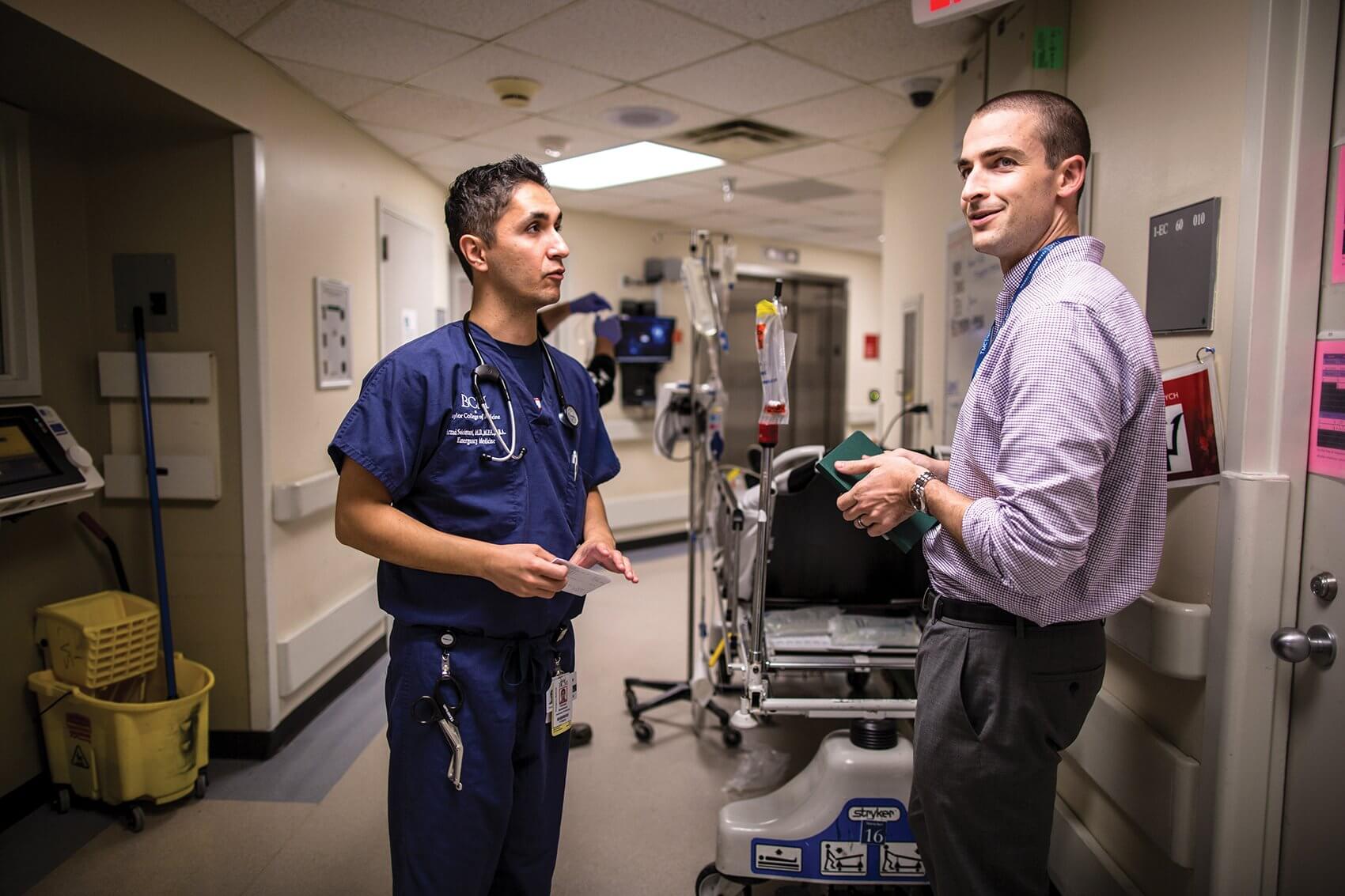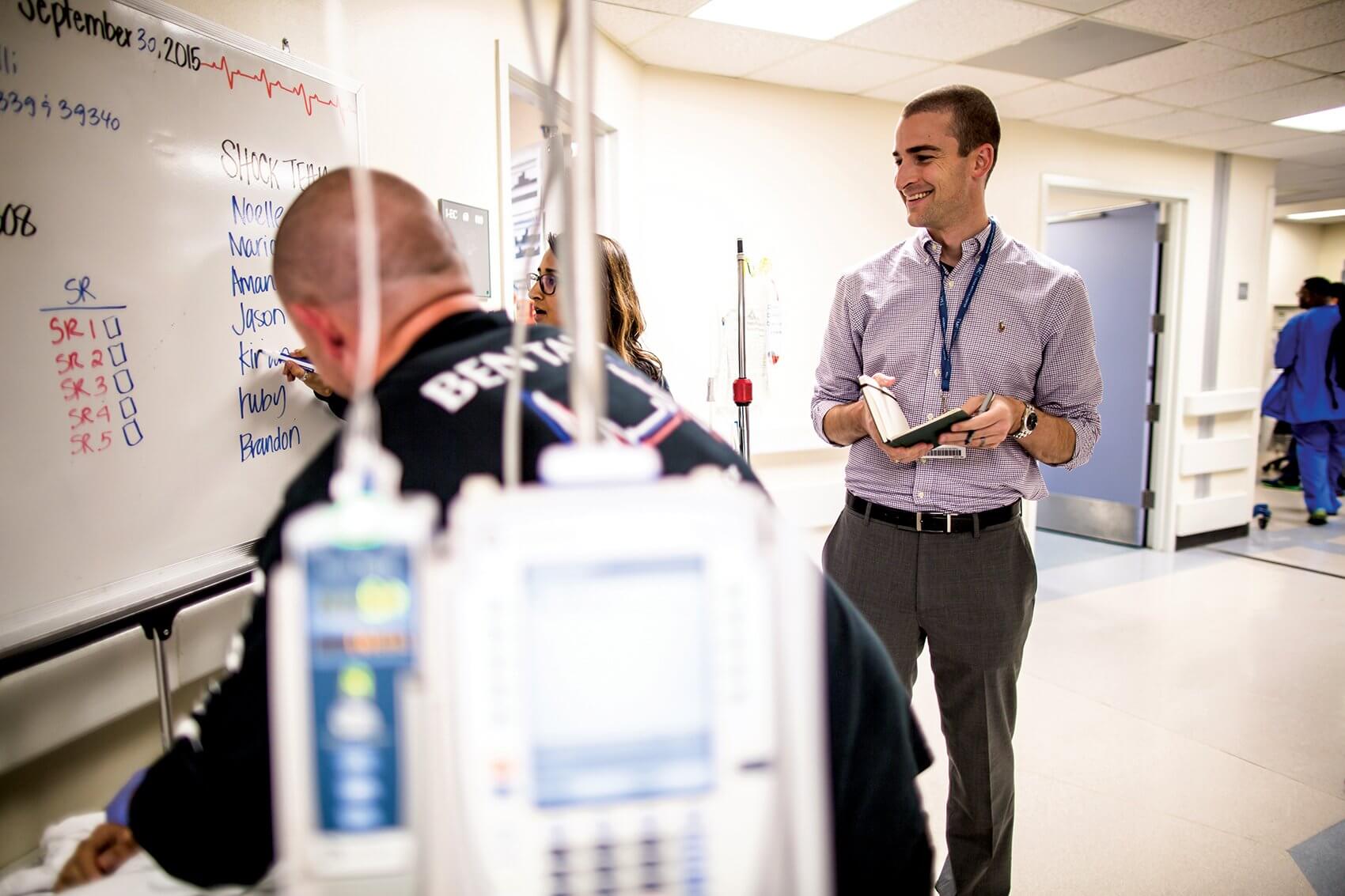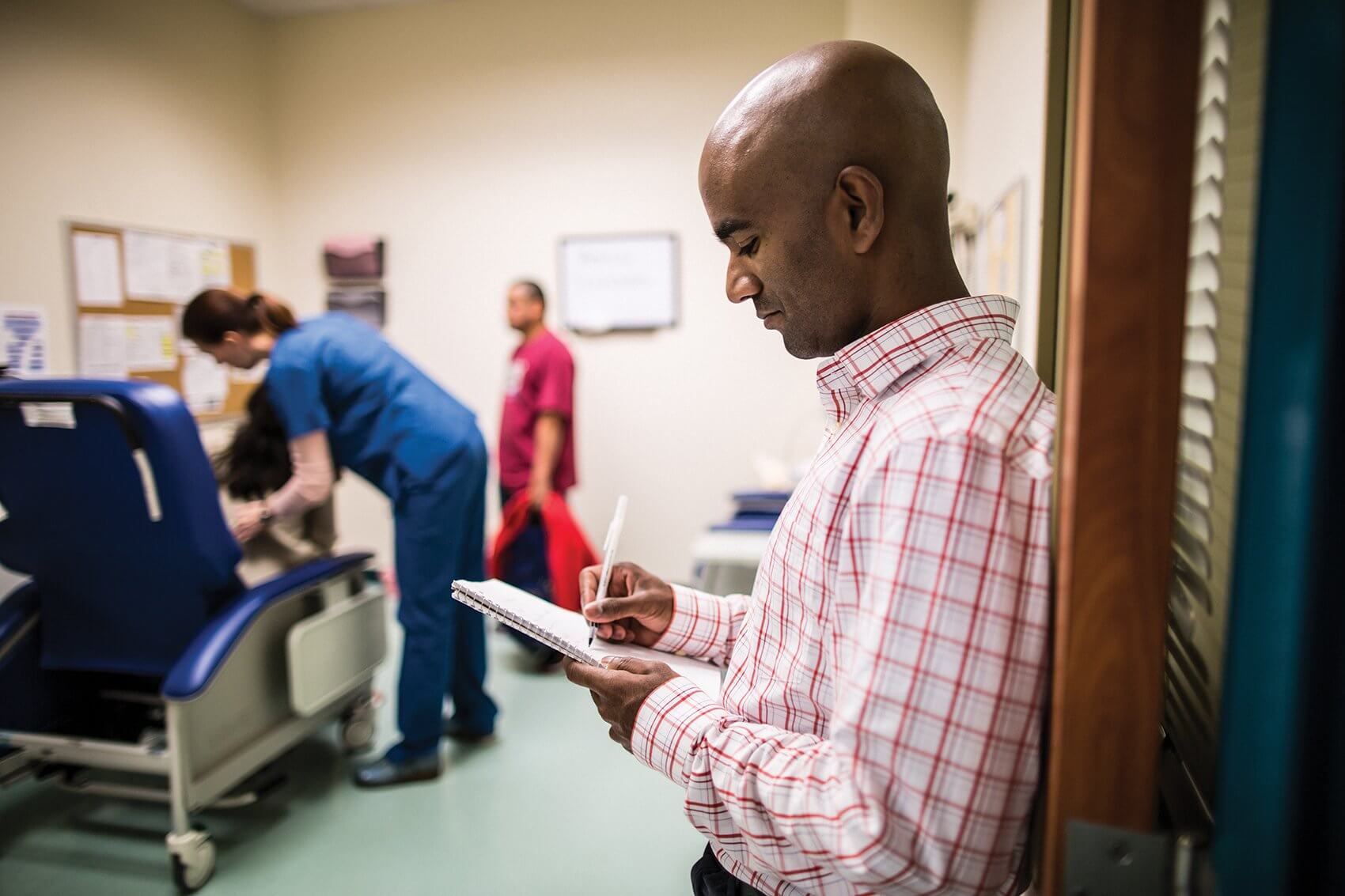Shadowing for Solutions

In the emergency department at Harris Health System’s Ben Taub General Hospital, the shuffle of hurried footsteps and the squeak of stretchers whistling past reverberate through the halls. Punctuated by the sharp, irregular beeping of all types of monitoring equipment and the hum of urgent conversation, a symphony of controlled chaos is conducted. At the center of it all, Dave Morris scribbles diligently in his notebook. Occasionally flattening himself against the wall to avoid a collision, he surveys the scene with the mindset of a hyper-vigilant reporter.
“We’re really looking for any kind of inefficiencies, redundancies or rote tasks being performed,” said Morris, a digital health fellow in the inaugural class of TMC Biodesign, the Texas Medical Center’s one-year innovation fellowship that brings together talented, multidisciplinary individuals to create digital health solutions and new medical devices. “If you stop someone and say, ‘Hey, why did you do that?’ you can find all kinds of interesting things about that process. Through our questioning, we really dig in and try to get medical professionals to tell a story about why they did something a certain way.”
Several blocks away at Texas Heart Institute, medical device fellows act as silent sentinels in the cardiovascular surgery operating room. As anesthesiologists, nurses and surgeons maneuver their instruments in tandem, the fellows keep a keen eye on the proceedings, trying to distill potential problem areas from a visually tangled tapestry of tubes, wires, organs and veins. In every operation, from coronary bypasses to valve replacements and left ventricular assist device (LVAD) implantations, that guiding question is the same: “Why did they do that—and is there any way that they can do it better?”
“We’re really trying to understand how these procedures are performed, what steps the practitioners take and how we can identify anything that stands out as inefficient or clunky from an engineering standpoint,” said Jessica Traver, a TMC Biodesign medical device fellow. “We see the surgery differently than the people who do it every day, so we look to see if the process seems hindered by any obstacles, or if it takes substantial time and effort to get it right.”
Traver and Morris—and their teammates in the medical device and digital health tracks, respectively—are currently in the “identify” stage of the biodesign process, an established methodology for streamlining innovation cultivated by Paul G. Yock, M.D., at Stanford University. The first part of the program’s curriculum, the “identify” stage involves the fellows going through an immersive clinical shadowing experience, during which they closely monitor patients and providers in distinct clinical settings. Afterward, they use those initial observations to catalogue unmet needs that might benefit from the creation of a new medical device or digital health technology. This stage is followed by two more: “invent” and “implement.”
For the four members of TMC Biodesign’s digital health team, the emergency department at Ben Taub Hospital—a bustling, Level I trauma center that cares for more than 100,000 emergency patients each year—was ripe for disruption.
“A lot of our emergency departments across the country are afflicted with the problem of having too many people in the waiting room and triaging patients to appropriate care areas,” said Farzad Soleimani, M.D., assistant professor of emergency medicine at Baylor College of Medicine and co-associate director of TMC Biodesign. “They’re also seeing problems with transitions of care. There’s a certain disconnect in the emergency room—you see a snapshot of a patient, unfortunately, at the moment when they’re the sickest. One of the themes that’s emerging is how to provide the necessary infrastructure, tools and IT insights to allow the health care providers to get a better sense of that patient’s journey through the medical system.”
While the digital health fellows have been keeping pace with the frenetic atmosphere of the ER, the medical device team has become embedded in the world of cardiovascular medicine. From the operating room and the clinic to the electrophysiology suite, they’ve gracefully accepted their roles as informational sponges, piecing together the intricate patchwork of cardiovascular health from as many angles as possible.
“If you look at cardiovascular devices, in the past decade the number of new technologies and techniques that have been introduced is mind boggling,” said William “Billy” E. Cohn, M.D., director of the Center for Technology and Innovation at Texas Heart Institute, as well as director of the department of surgery incubator at Baylor College of Medicine. “Some of the techniques we use might prompt someone to say, ‘Wow, that’s awfully barbaric.’ And upon reflection, they’re right—some of the stuff that we used in the operating room is fairly low-tech, such as using a needle and thread to sew things together, but that’s been the genesis for most of the major innovations in cardiovascular surgery in the past decade.”
In addition to their shadowing experiences throughout the Texas Medical Center, the fellows have been participating in a robust educational curriculum that exposes them to guest lecturers, while solidifying the biodesign methodology itself.
“What we’re trying to do on the education side is teach them the methodology for observation and needs identification,” said Eric S. Richardson, Ph.D., co-associate director of TMC Biodesign and a lecturer at Rice University. “It’s about teaching them how to not just observe, but how to look, specifically, for unmet needs. How do you act as a social scientist as well as an engineer? We want them to shut down the engineering side of their brain and think more about pain points, processes and flow. Those are the elements that will lead to interesting design projects.”
As the eight fellows look down the road at the next chapters of their biodesign journey—the “invent” stage, where they’ll prototype multiple devices and technologies simultaneously, and finally “implement,” where they focus on development strategy and market integration—their aspirations for the program itself are beginning to coalesce.
“I think developing a startup is a very ideal outcome, but I don’t think that should be the only outcome,” said Yashar Ganjeh, Ph.D., a TMC Biodesign fellow focused on medical devices. “I think going through the biodesign process, networking with advisors and mentors, and all of the entrepreneurs that are present throughout the weekly events, are the most important components of this program. Going through the product development process is way more important than actually making a company. For me, success is measured in what I learn throughout the experience and all of the resources provided here.”
“The idea of cultivating that skillset and learning to look through those lenses of viewing every step, device, procedure and diagnostic process as an opportunity for innovation and improvement is a completely different way of looking at the world,” added Cohn, an avid supporter of TMC Biodesign since its inception. “For health care professionals, we look at what’s been given to us, memorize the procedure and carry on. That series of prescriptive steps is something that you learn and master—we aren’t trained to push back against that and ask, ‘Why do I have to do it this way?’ That’s the skillset that these biodesign fellows are trying to cultivate. It’ll be interesting to see what they come up with.”
Meet the Biodesign Fellows
(Click to enlarge)







